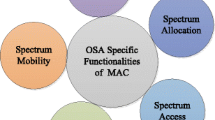Abstract
Recently, the opportunistic spectrum access (OSA) technologies have drawn a lot of the research community attention, because, by utilizing cognitive radio (CR) capabilities, they provide us with solutions to compensate for the spectrum underutilization. The MAC design is an important aspect of this on-going research. In this paper we study the performance of the distributed coordination function (DCF) in the OSA environment, which requires periodic intermissions to the MAC operation for spectrum scan procedures and opportunities identification. We present several modifications to the DCF that render it robust and operational in demanding environments of frequent spectrum scan procedures and low achievable transmission rates. We also present an analytical model for the throughput calculation of the resulted Intermittent DCF, which is based on the Bianchi’s Markov model and extends it so as to include the intermittent nature of the OSA environment. The proposed model is validated through simulations. A new parameter, controllable by the CR terminals, is used to optimize the throughput performance in realistic OSA scenarios. Using the presented analytical model we evaluate the performance of the Intermittent DCF under the effect of certain design parameters.
Similar content being viewed by others
References
Adamis, A. V., & Constantinou, P. (2007). Performance study of CSMA/CA over spectrum pooling environment for cognitive radios. In Proceedings of the 3rd IEEE international conference on wireless and mobile computing, networking and communications, New York, USA.
Adamis, A. V., Maliatsos, K. N., & Constantinou, P. (2008). Methods for reducing interference caused to licensed systems by overlay-CSMA/CA cognitive radios. In Proceedings of the 3rd international conference on cognitive radio oriented wireless networks and communications, Singapore.
Berthold, U., Heimpel, H., & Jondral, F. (2007). Coordination of allocation measurements in OFDM based ad hoc overlay systems. In Proceedings of IEEE international conference on acoustics, speech and signal processing, Honolulu, USA.
Berthold, U., & Jondral, F. (2005). Guidelines for designing OFDM overlay systems. In Proceedings of new frontiers in dynamic spectrum access networks (pp. 626–629), Baltimore, MD, USA.
Berthold U., Jondral F. K., Brandes S., Schnell M. (2007) Ofdm-based overlay systems: A promising approach for enhancing spectral efficiency. IEEE Communications Magazine 45(12): 52–58
Bianchi G. (2000) Performance analysis of the IEEE 802.11 distributed coordination function. IEEE Journal on Selected Areas in Communications 8(3): 535–547
Choi, N., Patel, M., & Venkatesan, S. (2006). A full duplex multi-channel mac protocol for multi-hop cognitive radio networks. In Proceedings of the 1st international conference on cognitive radio oriented wireless networks and communications, Mykonos Island, Greece.
Duffy K., Malone D., Leith D. (2005) Modeling the 802.11 distributed coordination function in non-saturated conditions. IEEE Communication Letter 9(8): 715–717
ET Docket No 02-155. (2002). Spectrum policy task force, report of the spectrum efficiency working group. Techical report, FCC.
Ghasemi A., Sousa E. S. (2008) Spectrum sensing in cognitive radio networks: Requirements, challenges and design trade-offs. IEEE Communications Magazine 46(4): 32–39
Hadzi-Velkov, Z., & Spasenovski, B. (2003). Saturation throughput—Delay analysis of IEEE 802.11 dcf in fading channel. In International conference on communications, 2003. ICC’03 Anchorage, AK, USA.
Hsu, A., Wei, D., & Kuo, C. (2007). A cognitive mac protocol using statistical channel allocation for wireless ad-hoc networks. In Proceedings of IEEE WCNC’07, Hong Kong.
Ibrahim, M., & Alouf, S. (2006). Lecture notes in computer science, chap. In Design and analysis of an adaptive backoff algorithm for IEEE 802.11 DCF mechanism (pp. 184–186). Berlin/Heidelberg: Springer.
Jia J., Zhang Q., Shen X. (2008) HC-MAC: A hardware-constrained cognitive mac for efficient spectrum management. IEEE Journal on Selected Areas in Communications 26(1): 106–117
Kay S. M. (1998) Fundamentals of statistical signal processing, volume II—Detection theory. Prentice Hall PTR, NJ
Liang Y. C., Zeng Y., Peh E. C., Hoang A. T. (2008) Sensing-throughput tradeoff for cognitive radio networks. IEEE Transactions On Wireless Communications 7(4): 1326–1337
Motamedi, A., & Bahai, A. (2007). Mac protocol design for spectrum-agile wireless networks: Stochastic control approach. In Proceedings of new frontiers in dynamic spectrum access networks, Dublin, Ireland.
Nan, H., Hyon, T. I., & Yoo, S. J. (2007). Distributed coordinated spectrum sharing mac protocol for cognitive radio. In Proceedings of new frontiers in dynamic spectrum access networks, Dublin, Ireland.
Papadimitratos P., Sankaranarayanan S., Mishra A. (2005) A bandwidth sharing approach to improve licensed spectrum utilization. IEEE Communications Magazine 43(12): supl.10–supl.14
Part 11. (1999). Wireless LAN medium access control (MAC) and physical layer (PHY) specifications. IEEE 802.11 WG.
Part 11. (1999). Wireless LAN medium access control (MAC) and physical layer (PHY) specifications: High speed physical layer in the 5 GHz Band. IEEE 802.11a WG.
Pawetczak, P., Pollin, S., So, H.S.W., & Motamedi, A. (2008). State of the art in opportunistic spectrum access medium access control design. In Proceedings of the 3rd international conference on cognitive radio oriented wireless networks and communications, Singapore.
Shu, J., Yang, X., & Guo, X. (2007). Disruptive csma with credit payback (cp) protocols for multi-radio network. In Proceedings of the 2nd international conference on cognitive radio oriented wireless networks and communications, Orlando, FL, USA.
SSC: Shared spectrum company: Spectrum occupancy measurements. http://www.sharedspectrum.com/measurements/.
Su H., Zhang X. (2008) Cross-layer based opportunistic mac protocols for qos provisioning over cognitive radio wireless networks. IEEE Journal on Selected Areas in Communications 26(1): 118–129
Weiss T. A., Jondral F. K. (2004) Spectrum pooling: An innovative strategy for the enhancment of spectrum efficiency. IEEE Communications Magazine 42(3): 8–14
Yuan, Y., Bahl, P., Chandra, R., Chou, P., Ferrell, J. I., Moscibroda, T., Narlanka, S., & Wu, Y. (2007). KNOWS: Cognitive radio networks over white spaces. In Proceedings of new frontiers in dynamic spectrum access networks, Dublin, Ireland.
Ziouva E., Antonakopoulos T. (2002) CSMA/CA under high traffic conditions: throughput and delay analysis. Elsevier, Computer Communications 25: 313–321
Author information
Authors and Affiliations
Corresponding author
Rights and permissions
About this article
Cite this article
Adamis, A.V., Maliatsos, K., Cambourakis, G. et al. Throughput Analysis of the Intermittent DCF for Opportunistic Spectrum Access. Wireless Pers Commun 55, 349–377 (2010). https://doi.org/10.1007/s11277-009-9817-x
Received:
Accepted:
Published:
Issue Date:
DOI: https://doi.org/10.1007/s11277-009-9817-x




